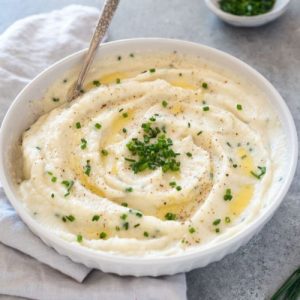
Garlic Mashed Cauliflower
A smooth and creamy low-carb side dish, Garlic Mashed Cauliflower is infused with buttery garlic flavor and fresh chives. Quick to prepare and naturally healthy, it’s an ideal addition to any dinner or meal prep plan, offering a satisfying, fiber-rich alternative to traditional mashed potatoes.
Equipment
- 1-Large pot
- 1-Colander
- 1 immersion blender (or food processor/blender)
Ingredients
- 1 large head cauliflower 2½–3 lbs, cut into florets
- 3 cloves garlic smashed and peeled
- 3 tablespoons unsalted butter softened
- 4 tablespoons heavy cream room temperature
- 1 teaspoon kosher salt
- ½ teaspoon table salt
- ¼ teaspoon freshly ground black pepper
- ¼ cup fresh chives chopped
Instructions
- Prepare Ingredients: Start by gathering all your ingredients to ensure a smooth cooking process. Wash the cauliflower thoroughly under running water to remove any dirt or debris. Cut the cauliflower into uniform florets, about 2 inches each, which will help them cook evenly. Peel the garlic cloves and lightly smash them with the flat side of a knife to release their flavor. Set the butter and heavy cream on the counter to reach room temperature, as this will make them easier to incorporate later.
- Boil Cauliflower and Garlic: Place the cauliflower florets and smashed garlic into a large, deep pot. Pour in enough water to cover the vegetables by about 1 inch. Cover the pot with a lid and bring the water to a rolling boil over medium-high heat. Once boiling, remove the lid and reduce the heat to medium to maintain a gentle simmer. Cook for 10–15 minutes, checking occasionally, until the cauliflower is completely tender and can be easily pierced with a fork. The garlic will also soften during this process, infusing the cauliflower with flavor.
- Drain Thoroughly: Once the cauliflower and garlic are fully cooked, carefully drain them in a colander. Shake off any excess water, as too much moisture can make the mash watery. Let the cauliflower sit in the colander for a few minutes to allow any residual water to escape. Proper draining is essential for achieving a creamy, thick texture in the final mash.
- Purée the Cauliflower: Return the drained cauliflower and garlic to the empty pot. Using an immersion blender, purée the mixture until completely smooth. If you don’t have an immersion blender, transfer the vegetables to a food processor or standard blender, working in batches if necessary. Blend until the texture is silky, with no lumps remaining. Take your time during this step to ensure a luxurious, creamy consistency.
- Incorporate Butter and Cream: Add the softened butter and room-temperature heavy cream to the puréed cauliflower. Stir gently but thoroughly, allowing the butter to melt evenly into the mash. The cream will add richness and a velvety texture. Taste as you stir, noting the natural sweetness of the cauliflower balanced with the creamy, buttery flavor.
- Season the Mash: Sprinkle in both the kosher and table salt, as well as the freshly ground black pepper. Stir again to distribute the seasonings evenly. Taste and adjust seasoning if necessary. The salt enhances the natural flavors, while the pepper adds a subtle depth. Seasoning gradually allows you to control the flavor without overpowering the delicate garlic and cauliflower.
- Add Fresh Chives: Fold in the freshly chopped chives, reserving a small amount for garnish if desired. The chives provide a mild onion-like flavor and a vibrant green color that brightens the dish. Stir gently to ensure they are evenly distributed throughout the mash without losing their texture and freshness.
- Serve Warm: Transfer the Garlic Mashed Cauliflower to a serving dish and garnish with the reserved chives, if desired. Serve immediately while warm to enjoy its creamy texture at its best. This mash pairs wonderfully with roasted meats, grilled vegetables, or as a comforting side for any meal.
Notes
- For best flavor, use a fresh, firm cauliflower head. Pre-cut florets from the store are convenient, but a whole head is more cost-effective and flavorful.
- Allow the butter and heavy cream to come to room temperature before mixing. This ensures a smooth, creamy mash without clumps.
- Overcooking the cauliflower can make the mash watery. Aim for tender, fork-soft florets that hold their shape while puréeing.
- If the mash turns out slightly thin, stir in a small amount of cream cheese, Greek yogurt, or sour cream to thicken it without altering the flavor.
- Fresh chives are ideal, but finely chopped green onions or parsley can be used as an alternative garnish.